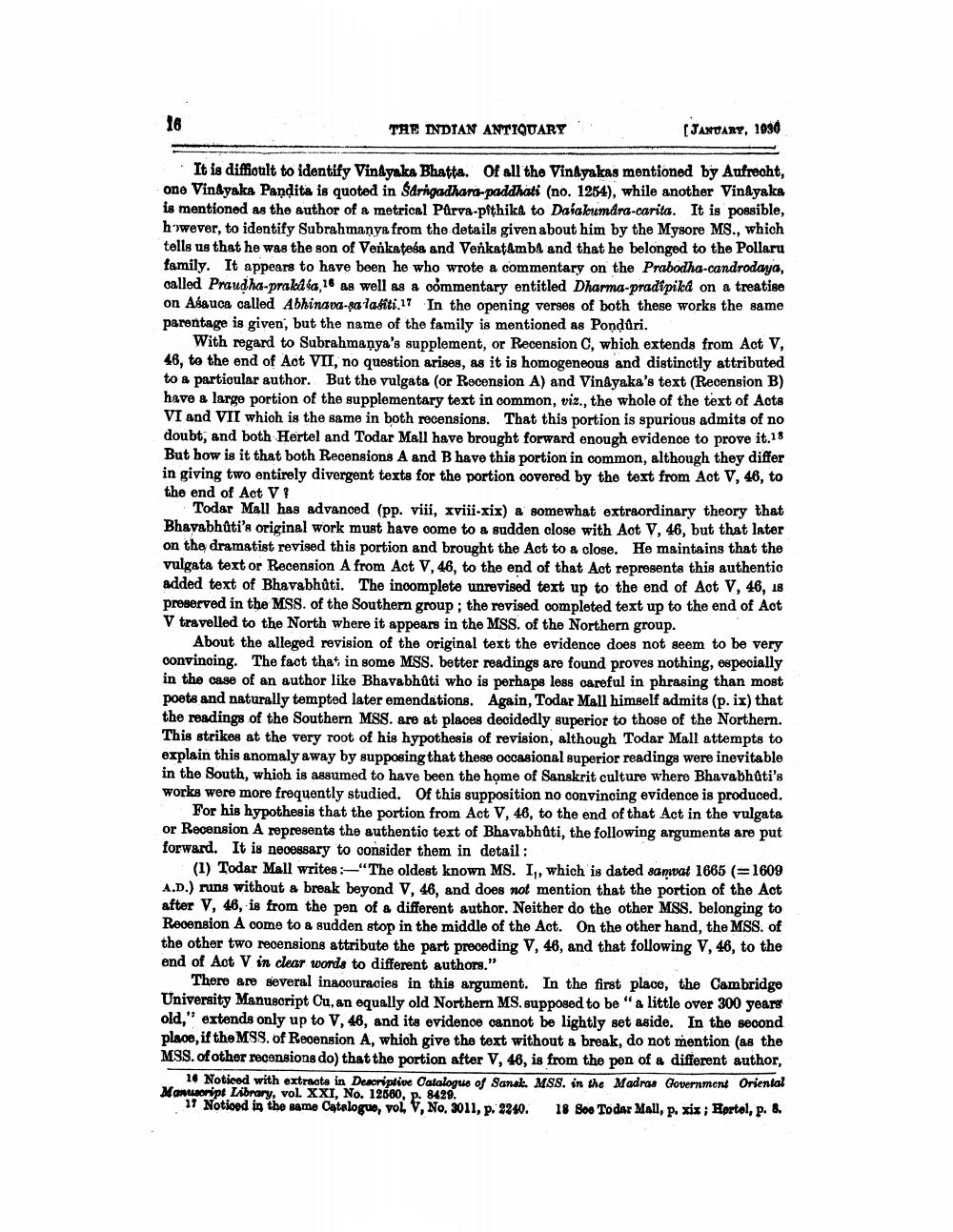________________
THE INDIAN ANTIQUARY
(JANUARY, 1990
It is diffioult to identify VinAyaka Bhatta. Of all the Vinayakas mentioned by Aufrecht, one Vinayaka Pandita is quoted in Sarngadhara-paddhati (no. 1254), while another Vinayaka is mentioned as the author of a metrical Parva-pfthika to Daiakumdra-carita. It is possible, h-wever, to identify Subrahmanya from the details given about him by the Mysore MS., which tells us that he was the son of Venkatesa and VenkatambA and that he belonged to the Pollaru family. It appears to have been he who wrote a commentary on the Prabodha-candrodaya, called Praudha-prakasa, 16 as well as a commentary entitled Dharma-pradipikd on a treatise on Asauca called Abhinava-salafiti 17 In the opening verses of both these works the same parentage is given, but the name of the family is mentioned as Ponduri.
With regard to Subrahmanya's supplement, or Recension C, which extends from Act V, 46, to the end of Act VII, no question arises, as it is homogeneous and distinctly attributed to a particular author. But the vulgata (or Recension A) and Vinayaka's text (Recension B) have a large portion of the supplementary text in common, viz., the whole of the text of Acts VI and VII which is the same in both recensions. That this portion is spurious admits of no doubt, and both Hertel and Todar Mall have brought forward enough evidence to prove it.18 But how is it that both Recensions A and B have this portion in common, although they differ in giving two entirely divergent texts for the portion covered by the text from Act V, 46, to the end of Act V?
Todar Mall has advanced (pp. viii, xviii-xix) a somewhat extraordinary theory that Bhavabhūti's original work must have come to a sudden close with Aot V, 46, but that later on the dramatist revised this portion and brought the Act to a close. He maintains that the vulgata text or Recension A from Act 1, 46, to the end of that Act represents this authentic added text of Bhavabhūti. The inoomplete unrevised text up to the end of Act V, 46, 18 preserved in the MSS. of the Southern group; the revised completed text up to the end of Aot V travelled to the North where it appears in the MSS. of the Northern group.
About the alleged revision of the original text the evidence does not seem to be very convincing. The fact that in some MSS. better readings are found proves nothing, especially in the case of an author like Bhavabhūti who is perhaps less careful in phrasing than most poets and naturally tempted later emendations. Again, Todar Mall himself admits (p.ix) that the readings of the Southern MSS. are at places decidedly superior to those of the Northern. This strikes at the very root of his hypothesis of revision, although Todar Mall attempts to explain this anomaly away by supposing that these occasional superior readings were inevitable in the South, which is assumed to have been the home of Sanskrit culture where Bhavabhūti's works were more frequently studied. Of this supposition no convincing evidence is produced.
For his hypothesis that the portion from Act V, 46, to the end of that Act in the vulgata or Recension A represents the authentic text of Bhavabhậti, the following arguments are put forward. It is necessary to consider them in detail :
(1) Todar Mall writes "The oldest known MS. I, which is dated samvat 1665 (= 1609 A.D.) runs without a break beyond V, 46, and does not mention that the portion of the Act after V, 46, is from the pon of a different author. Neither do the other MSS. belonging to Recension A come to a sudden stop in the middle of the Act. On the other hand, the MSS. of the other two recensions attribute the part preceding V, 46, and that following V, 46, to the end of Aot V in clear words to different authors."
There are several inacouracies in this argument. In the first place, the Cambridge University Manuscript Cu, an equally old Northern MS.supposed to be "a little over 300 years old," extends only up to V, 46, and its evidence cannot be lightly set aside. In the second place, if the MSS. of Recension A, which give the text without & break, do not mention (as the MSS. of other recensions do) that the portion after V, 46, is from the pon of a different author,
16 Noticed with extracts in Descriptive Catalogue of Sanak. MSS. in the Madras Government Oriental Montoript Library, vol. XXI, No. 12560, p. 8429.
11 Notiood in the same Cataloguo, vol, V, No. 3011, p. 2240. 18 Soo Todar Mall, p. xix ; Fprtol, p. &.




